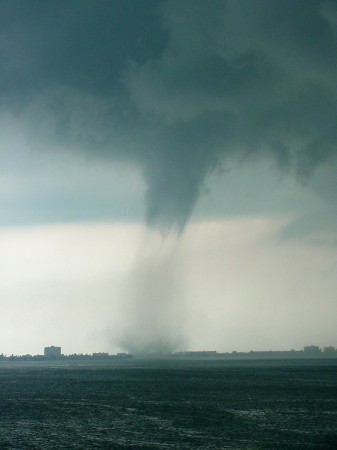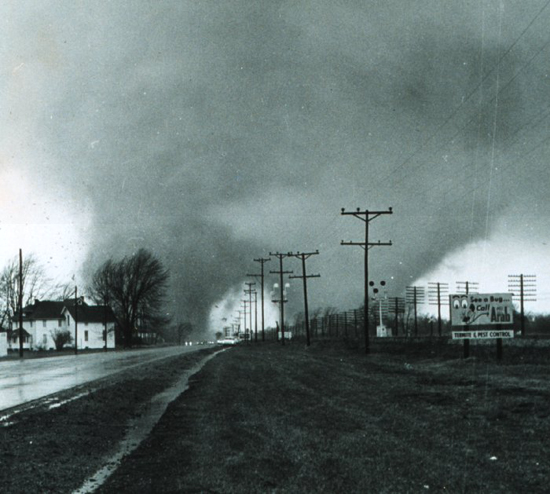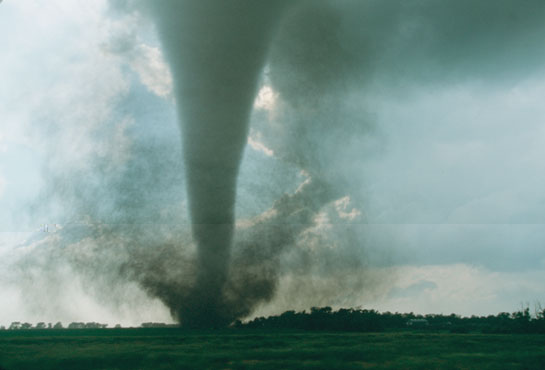
Image courtesy of http://blogs.tampabay.com/nie/images/2009/01/30/30tornado.jpg
Tornado Facts
¤ Official records of Tornadoes date back to 1950, so we don't know the real average of tornadoes that occur each year; However, in the United States it is estimated that about 1,000 tornadoes occur each year.
¤ In Tornado Alley--Texas, Oklahoma, Kansas, and Nebraska--the tornado season is in May and early June. If you go there during the peak of tornado season, you will often see violent tornadoes.
¤ Tornadoes kill about 60 people every year from falling debris, or from getting whipped around by a violent tornado.
¤ The deadliest tornado in history killed 695 people on March 18, 1925. This tornado's trail was the longest trail ever made by a tornado. At 219 miles, it went through Missouri, Illinois, and Kansas, and is known as the Tri-State Tornado.
¤ Codell, Kansas was hit by a tornado on May 20th for three consecutive years. These years were 1916, 1917, and 1918.
¤ Waterspouts are weak tornadoes that form over water, and are most commonly seen around the Gulf Coast. These can sometimes come on the land and become a tornado.
¤ 69% of all tornadoes are weak tornadoes, and account for less than 5% of tornado-caused deaths. Their wind speed should be less than 110 miles per hour, which is an EF 1 or EF 2 tornado. They can last from a range of 1 minute to 10 minutes.
¤ 29% of all tornadoes are strong tornadoes, and they account for 30% of all deaths caused by a tornado. It can last 20 minutes or longer, and has wind speeds of up to 110-205 miles per hour!
¤ Only about 2% of all tornadoes are Violent tornadoes; They cause 70% of all recorded tornado deaths, and can last for over an hour.
Facts Courtesy Of:
http://www.nssl.noaa.gov/primer/tornado/tor_climatology.html
http://www.nssl.noaa.gov/edu/safety/tornadoguide.html
Myths VS. Facts
☼ One myth is that people who leave near rivers, lakes, or mountains are free of worry from tornadoes; However, this is not true because no place is free from the dangers of tornadoes. This is a proven fact because in the 1980's Yellowstone National Park had a tornado that went violently all the way up and down the 10,000ft mountain
☼ Another myth is that a tornado's low pressure causes a building to explode when it passes overhead, when in reality, it is the debris that is being thrown around that causes most of the damage to the building's structure.
☼ Another common myth is that opening a window will minimize the damage done to the house, but that just lets the damaging winds inside of the house, and actually makes it a lot less safe. The best thing you can do during a tornado is to hide in a safe place.
☼ Some people say that going to the Southwest corner of your basement is the safest place, but some of the studies have actually proven that this could very well be the most dangerous place in your basement to go. If the tornado hits the Southwest side of your house, the debris could fly in and hit you.
Myths and Facts Courtesy of:
http://www.nssl.noaa.gov/edu/safety/tornadoguide.html
http://www.april31974.com/tornado_myths_and_facts.html

» Two tornado funnels formed in Elkhart, Indiana on April 11, 1965.
» During this same tornado outbreak, a double tornado was also seen around Toledo.
Information From: http://www.ohiohistory.org/etcetera/exhibits/swio/pages/albums/1965_tornadoes/1965_tornadoes_albumPage01.html
Tornado Safety

Picture From http://www.cs.uwaterloo.ca/~jwlwan/projects/zm_zoomin.jpg
Click Here For A Video Of A Tornado's Destructive Force--Thanks to National Geographic!
٭ Make sure your family, work, and/or school all have a plan for severe weather
٭ Practice your plan frequently during drills
٭ Keep a map with you so you can track storm movement from the weather bulletins or radio warnings
٭ Listen to the radio and/or television for information on the coming storm
٭ Make sure you have a place to hide beforehand, such as a basement
٭ If you have no basement, go to a room with no windows and hide under a sturdy piece of furniture
٭ Do NOT stay in a car, bus, or truck when there is a tornado warning
٭ Mobile homes are not good shelter when a tornado is coming by
Safety tips from http://www.nssl.noaa.gov/edu/safety/tornadoguide.html
Page Background From http://www.layoutpimperz.com/Images/Backgrounds/Color_Backgrounds/Bluish_Grey_Backgrounds/images/blue-grey-myspace-background-120.gif
Website By Leah Larson